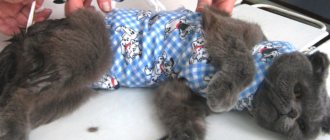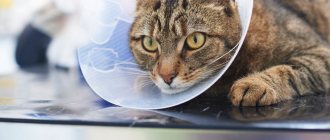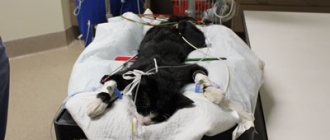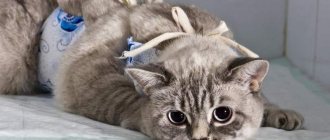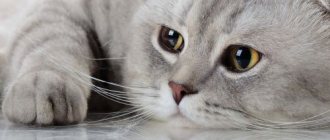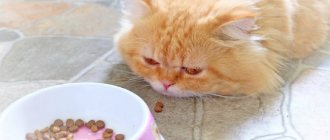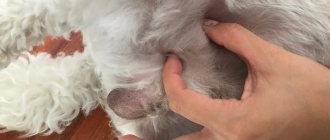Why does a cat mark? More precisely, it is the cat who marks most often - and there are many reasons for this: from the habits of wild ancestors that modern domestic cats have retained, to a stressful situation that forces the cat to mark the territory. What to do if a cat marks in the apartment? Maxim Andreevich Bobrovsky, veterinarian at the IVC MBA, therapist, helps to understand the behavior of a pet and understand how castration of cats occurs.
For millions of years, animals on our planet have had to interact in one way or another with each other and with the environment. Evolutionarily, nature has divided the methods of social organization of animals into solitary and group. Cats, unlike many other species, with rare exceptions lead a solitary lifestyle.
But a completely solitary way of life does not exist in nature - animals have to meet for the purpose of procreation, dividing zones of influence, and hunting together. Cats are no exception in this regard. However, representatives of the cat family, leading a solitary lifestyle, in most cases try not to meet and interact with each other through biological signaling: leaving claw marks on trees, gland secretions and urine marks.
The ability to mark territory allows animals in the wild to receive information about the owner of the left marker - gender, age, physiological state, time of the message left, and much more. This data helps animals communicate over vast territories without meeting each other.
Despite the consequences of domestication, the cats living with us have retained many of the habits of their wild ancestors. And although the domestic cat is content with a much smaller territory than its wild counterparts, it still actively uses all types of biological signaling. Unfortunately, in conditions of exclusively home keeping, such behavior interferes with the comfortable coexistence of a person and a cat.
Why does the cat mark?
Most often, males mark with urine, 80-90% of which are not castrated. Although, according to some data, from 2 to 5% of females can also resort to this method of marking and signaling, albeit noticeably less frequently. When and why do animals do this?
Uncastrated males are able to begin marking territory at 5-6 months. Most often, this phenomenon is observed during puberty, due to the appearance of other animals in the house, in case of frequent conflicts between animals, as a result of changes in the environment (repairs, remodeling, moving) or due to stress (a trip to the veterinarian, grooming etc.).
How can owners understand whether an animal is actually marking territory or is it something else? It often happens that a cat urinates in the “wrong” place. But that doesn't mean she's aiming. This situation is a reason to consult a veterinarian.
It is quite easy to recognize the process of physiological signaling: cats usually mark vertically located objects (trees, walls, legs and bases of household furniture, curtains, house plants, etc.), and do not sit down, as in the case of urination, but do it while standing, raising his tail. At the same time, slight twitching of the tail and the whole body occurs. The amount of urine sprayed by animals is quite small compared to normal urination.
Diseases of the genitourinary system
Cats are naturally very clean and will never pee in their home. But sometimes animals trained to use the tray begin to pee anywhere. This behavior is not always a sign of poor cat upbringing. The most common cause is a serious illness, such as kidney failure. The most common diseases associated with cat misbehavior are :
- Urinary incontinence. A cat does not pee outside of its litter box on purpose - it simply cannot control this process. Typically these places are a bed, carpet or shoes;
- Urinary incontinence can develop as a result of inflammatory processes, injuries or diseases of the spine, or ectopia of the ureters. Cats can also suffer from this disease in old age;
- Severe stress. The cat begins to pee in strange and atypical places, for example, in a flower pot. The cat may be jealous of the owner for a new family member or pet, bored or worried about the owner’s illness. Cats often show jealousy towards newborns by peeing on the baby's toys and other things. In such a situation, it is very important to calm and caress the cat, to show it that you love it;
- Urolithiasis or urolithiasis. The disease affects genetically predisposed cats, older cats, as well as those who eat cheap dry food. Kidney stones cause a lot of troubles and problems with urination for a cat. The cat may feel an urge, but it is difficult to write;
- Cystitis. This inflammatory process is similar in its symptoms to ICD. With this disease, the cat pees past the litter box or in an unnatural position for it (for example, standing).
The reason for your pet’s bad behavior may be a disease of the genitourinary system. Some of the most common are pyelonephritis, nephritis, glomerulonephritis (kidney inflammation), and ureitis. The cat may also suffer from atony - impaired peristalsis. With this disease, the cat involuntarily pees when its bladder becomes full.
© shutterstock
Monitor your cat's health - if she has difficulty urinating or the color of her urine changes, contact your veterinarian immediately.
Castration of a cat: will it help if the cat marks?
In most cases, the solution to the problem is castration (orchiectomy). After it, the animal’s need to mark its territory decreases. But castration does not guarantee the cessation of unwanted behavior. Much depends on factors such as:
- age of the animal: castration at an early age is more effective than castration at an older age;
- presence of other animals in the house. If there is a female cat in the house, especially during the period of heat, and also if there are frequent conflicts between animals of the same sex, even neutered cats may begin to mark their territory again;
- intensity of street exercise. Cats leading an active outdoor lifestyle find themselves in conditions as close as possible to wild nature, and therefore can exhibit their characteristic physiological behavior even after castration;
- frequency and intensity of mating: cats that have frequent sexual intercourse before castration are able to retain signs of sexual behavior for some time.
Consequences of anesthesia
Anesthesia of any type has a sedative effect on the nervous and muscular system. While your pet sleeps during and after surgery, he cannot control his urges. Involuntary may be:
- Vomiting - to prevent the cat from choking on the vomit and getting it into the respiratory tract, the four-legged cat should lie on its side. Most veterinarians will restrain animals on their backs (during surgery), but in this case, the owner is asked not to feed the pet for 10-12 hours before surgery. Some veterinarians operate on cats in the lateral position, which reduces the risk of vomiting, but impairs the surgeon’s visibility.
- Urination - during the operation, the cat is on a moisture-absorbing diaper, since the fasting diet before the operation does not imply water restriction. Sometimes doctors recommend not giving the cat water 2-3 hours before castration, but this is not entirely correct. Anesthesia is fraught with dehydration and the milder its degree, the easier the rehabilitation will be in the first hours.
- Defecation – the intestines can remain full for up to 8–10 hours after eating. If the cat is kept on a starvation diet, defecation may not occur until anesthesia is administered. Of course, such a surprise is a little unpleasant, but there is nothing unnatural about it.
Note! If you hold your cat while he is under anesthesia, be prepared for your clothes to get dirty.
In recent years, the need for a fasting diet for 12 hours before and after surgery has often been disputed. Veterinarians say that forced fasting for 24 hours leads to a slowdown in metabolism and sometimes irreversible consequences. A decrease in immune defense against the background of a slower metabolism has a negative effect.
Castration of a cat and caring for a pet after surgery
Castration surgery can be performed both under general anesthesia and under light sedatives in combination with local anesthesia. Before the operation, the animal must undergo an examination by a general practitioner and an anesthesiologist-reanimatologist in order to identify latent diseases and determine anesthetic risks. From a surgical point of view, this operation is quite simple, does not take much time and is in-line.
Postoperative care is simple. In many veterinary clinics, owners are offered to place the animal in a hospital for preparation for surgery and observations in the postoperative period. But sometimes owners cannot or do not want to leave their pets. In this case, before leaving home, you need to stay in the clinic’s waiting room in order to quickly respond and provide assistance to the animal recovering from anesthesia.
At home, you need to prepare a special place on the floor, equipping it with a soft bedding and a warm heating pad. If the animal lies on a bed, sofa or chair, it may be injured after an unsuccessful fall, since in the process of awakening from anesthesia it may experience impaired movement.
Warm water heaters or plastic bottles with warm water (35-40°C) are needed to protect the cat from a drop in temperature after surgery. If owners are skilled in rectal thermometry, periodic temperature readings will be helpful. The normal temperature of a cat is 38-39.5°C.
What to do?
If after sterilization the cat continues to shit, veterinary doctors recommend protecting the animal from stress and trying to calm it down.
The owner needs to give his pet maximum attention and care. Special collars also have a calming effect. They are saturated with a smell that reminds pets of their mother cat. Flower decoctions are also used for calming. They should be rubbed in a circular motion into the inner area of the auricle. Just put a drop of the product in one ear and rub in gently. The manipulation should be carried out several times a day. These products can also be added to the water your pet drinks. It is also permissible to resort to the help of medications that can help cope with desire and have a sedative effect. Veterinarians recommend using the following medications for cats that have been sterilized but continue to poop:
This remedy will gently calm the animal and help cope with its problem.
- "Stop Stress";
- "Cat Baiyun";
- "Fospasim";
- "Sex Barrier".
When a pet shits, it is strictly forbidden to punish it. Remarks to the owner should be made in a dissatisfied tone. At the same time, the cat is raised only at the moment of committing a prohibited act, so that it understands exactly what cannot be done. A product called Feliway will help get rid of the unpleasant odor left by cat marks. It contains a chemical substance that resembles the secretion secreted by the facial glands of a cat. Before using this composition, the owner will need to wash the cat's marks. Then you need to apply Feliway to the surface where the animal has pooped. The procedure should be carried out twice a day for 30 days.
Reason No. 12: the cat stopped going to the litter box after the dacha
Separately, it is worth considering the complaint that the cat, after walking outside or going to the country, stopped pooping and peeing in the litter box. This is due to the fact that many cats, having tasted the joy of going to the toilet outside, then do not recognize its substitute, that is, the litter box. Therefore, animal psychologists do not recommend allowing cats to pee and poop outside if you can control it.
But what to do if the problem has already appeared? Firstly, going to the toilet in the country should be avoided. Secondly, if possible, we don’t let the cat pee anywhere and spray it with a spray bottle if he settles down in another place, praise him for going to the litter box, and force him to go to those places where he has already gone. Plus, the advice about the lawn from the next section might be helpful.
Reason No. 12: the cat stopped going to the litter box after the dacha
Separately, it is worth considering the complaint that the cat, after walking outside or going to the country, stopped pooping and peeing in the litter box. This is due to the fact that many cats, having tasted the joy of going to the toilet outside, then do not recognize its substitute, that is, the litter box. Therefore, animal psychologists do not recommend allowing cats to pee and poop outside if you can control it.
But what to do if the problem has already appeared? Firstly, going to the toilet in the country should be avoided. Secondly, if possible, we don’t let the cat pee anywhere and spray it with a spray bottle if he settles down in another place, praise him for going to the litter box, and force him to go to those places where he has already gone. Plus, the advice about the lawn from the next section might be helpful.

